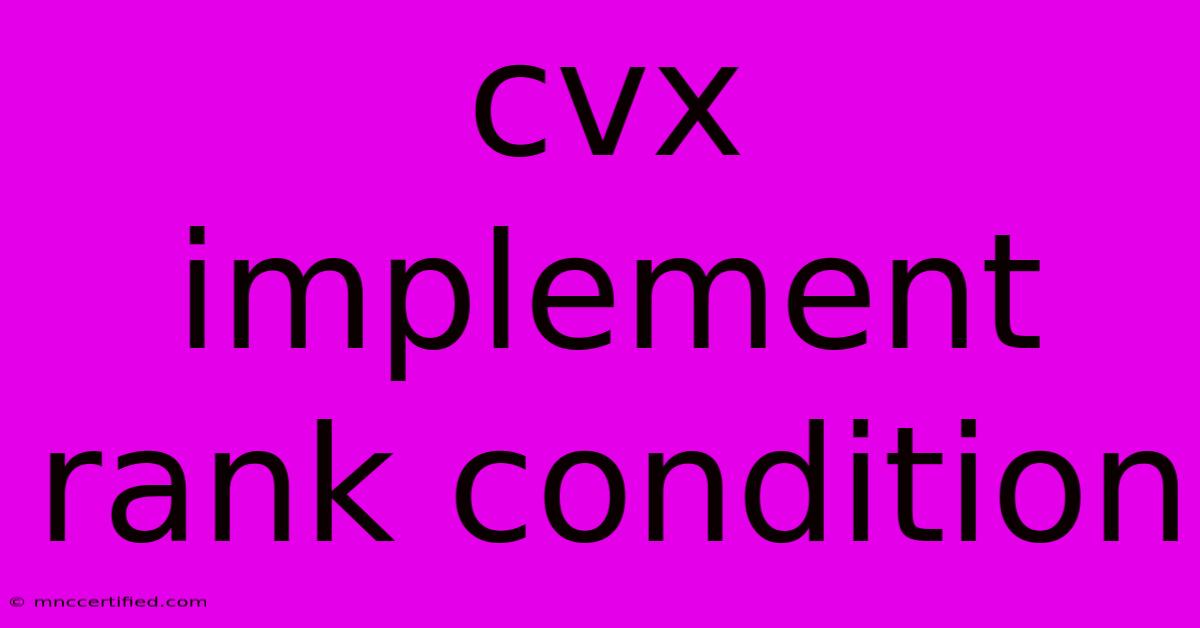Cvx Implement Rank Condition

Table of Contents
CVXPY: Implementing Rank Constraints for Optimal Performance
Convex optimization, a powerful tool in various fields, often requires incorporating rank constraints to accurately model real-world problems. However, directly enforcing rank constraints is generally NP-hard. This article delves into techniques for implementing rank constraints within the CVXPY framework, a popular Python-based convex optimization package. We'll explore different approaches, their limitations, and best practices for achieving optimal results.
Understanding the Challenge: Non-Convexity of Rank Constraints
The fundamental problem lies in the non-convexity of the rank function. Standard convex optimization solvers cannot directly handle non-convex constraints. Therefore, we need clever workarounds to approximate or relax rank constraints within a convex optimization setting.
Why are Rank Constraints Important?
Rank constraints are crucial in many applications, including:
- Low-rank matrix completion: Filling in missing entries of a matrix while maintaining a low rank. This is prevalent in recommender systems and data imputation.
- Robust principal component analysis (RPCA): Separating low-rank and sparse components from a data matrix, useful in image denoising and anomaly detection.
- Control theory: Designing controllers with minimal complexity, represented by a low-rank system matrix.
- Network analysis: Finding low-rank representations of network adjacency matrices to identify community structures.
Approximating Rank Constraints in CVXPY
Several techniques can approximate or relax rank constraints to fit within the convex framework of CVXPY:
1. Nuclear Norm Minimization
The nuclear norm, the sum of singular values of a matrix, is the tightest convex relaxation of the rank function. Minimizing the nuclear norm encourages low-rank solutions. In CVXPY, this is straightforward:
import cvxpy as cp
# ... define problem variables ...
# Minimize the nuclear norm
objective = cp.Minimize(cp.norm(X, 'nuc'))
# ... add other constraints ...
problem = cp.Problem(objective, constraints)
problem.solve()
Advantages: Relatively simple to implement, often yields good low-rank approximations.
Disadvantages: May not strictly enforce a specific rank; the resulting rank might be higher than desired.
2. Rank-Constrained Optimization using Semidefinite Programming (SDP)
While not directly supported in CVXPY's core functionality, rank constraints can be incorporated through SDP formulations. This involves reformulating the problem using semidefinite matrices and leveraging SDP solvers. This approach is generally more complex but can provide tighter approximations. This often requires more advanced knowledge of convex optimization theory and might involve using external SDP solvers.
3. Penalty Methods
Adding a penalty term to the objective function that penalizes high-rank solutions can be effective. A common choice is to add a penalty proportional to the nuclear norm or a trace norm.
import cvxpy as cp
# ... define problem variables ...
# Add a penalty term to the objective function
objective = cp.Minimize(cp.norm(X, 'nuc') + lambda_ * cp.trace(X.T @ X)) #Example with trace penalty
# ... add other constraints ...
problem = cp.Problem(objective, constraints)
problem.solve()
Where lambda_ is a tuning parameter controlling the strength of the penalty.
Advantages: Flexibility in adjusting the penalty strength; allows for incorporating other objectives.
Disadvantages: Requires careful tuning of the penalty parameter; may not guarantee a specific rank.
Best Practices for Implementing Rank Constraints in CVXPY
-
Choose the Right Approach: The best method depends on the specific problem and desired level of accuracy. Nuclear norm minimization is a good starting point for its simplicity, while SDP or penalty methods may be necessary for tighter approximations.
-
Parameter Tuning: For penalty methods, carefully tune the penalty parameter (
lambda_) to balance the rank constraint with other objectives. Experimentation and cross-validation are crucial. -
Problem Scaling: Ensure your problem is well-scaled to avoid numerical issues. Preprocessing your data can significantly improve performance.
-
Solver Selection: CVXPY supports various solvers. Experiment to find the most efficient solver for your specific problem.
-
Regularization: Consider adding regularization terms (e.g., L1 or L2 regularization) to enhance stability and prevent overfitting.
Conclusion
Implementing rank constraints in CVXPY requires careful consideration of the inherent non-convexity. By utilizing techniques like nuclear norm minimization, SDP formulations, or penalty methods, along with careful parameter tuning and solver selection, you can effectively approximate or relax rank constraints to solve complex optimization problems. Remember that the choice of method and parameter tuning heavily depend on the specific application and desired trade-off between solution accuracy and computational cost. Always validate the results thoroughly to ensure they meet the desired properties and constraints.

Thank you for visiting our website wich cover about Cvx Implement Rank Condition. We hope the information provided has been useful to you. Feel free to contact us if you have any questions or need further assistance. See you next time and dont miss to bookmark.
Featured Posts
-
Do You Have To Pay A Pr Bond
Nov 30, 2024
-
Barbour James Bond Commander
Nov 30, 2024
-
My Top Apple Watch Black Friday Deals
Nov 30, 2024
-
Home Insurance Cape Coral Fl
Nov 30, 2024
-
Surprise Aleppo Rebel Assault
Nov 30, 2024